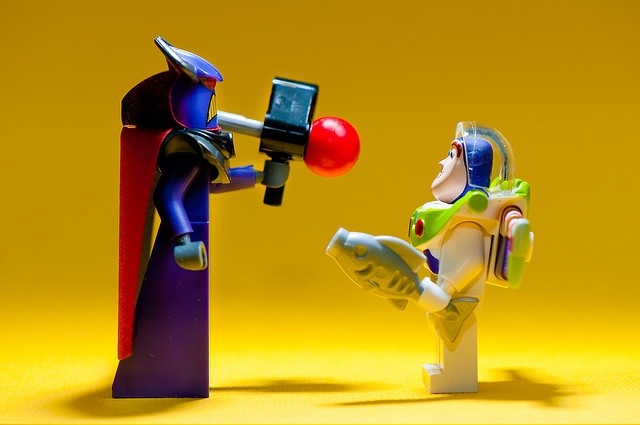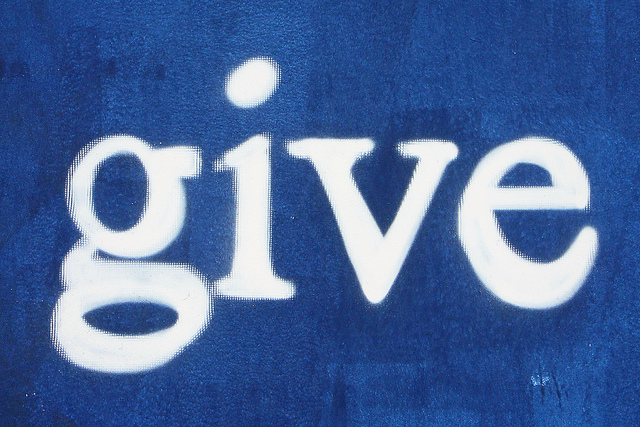Posts Tagged ‘Trust-based approach’
You Can’t Saw People in Half
 When there’s a big job, you’re taught to break it into a series of sub tasks, sequence them, and go after them with vigor. When there are different types of work within a job, you’re taught to break down the work into related bits of work, assign specialists, and take them on with the utmost efficiency. When there’s a big problem, you’re taught to break it into mini problems, solve them one at a time, and then recombine. This works sometimes, but more often than not, it doesn’t. The world is complex; everything’s interconnected; and the improvement itself can change the system and create a new and more powerful dilemma. Though we know this, divide and conquer is still the favorite first choice.
When there’s a big job, you’re taught to break it into a series of sub tasks, sequence them, and go after them with vigor. When there are different types of work within a job, you’re taught to break down the work into related bits of work, assign specialists, and take them on with the utmost efficiency. When there’s a big problem, you’re taught to break it into mini problems, solve them one at a time, and then recombine. This works sometimes, but more often than not, it doesn’t. The world is complex; everything’s interconnected; and the improvement itself can change the system and create a new and more powerful dilemma. Though we know this, divide and conquer is still the favorite first choice.
Okay, it works sometimes, and it’s reasonable to use it with projects and problems, but it doesn’t work on all things. And by far, the most egregious misuse of the separation principle is when it’s used on people.
Mind and body are parts of an inseparable whole, but in practice, that’s not how it goes. Exercise for the body improves the mind, but exercise is not mandatory. And in the long term, exercise is preventive maintenance for body and the mind – lower healthcare costs, happier people, more productivity, and better work. Our machines get preventive maintenance but our people don’t. For some reason, we think it’s possible to separate the mind from the body.
Home life and work life are two parts of a single, integrated, whole life, but in practice, they’re considered two independent elements. Much like the old magician’s trick, we’re sawed in half yet expected to function as a whole person at work. Too much work and the family suffers; and when the family suffers, the work suffers. It’s that simple. Not enough sleep at home, the work suffers. (And, maybe some sleep at work.) Crisis at home and no time off to take care of it, work suffers. Time away from the kids, the work suffers. The best way to create resentment and bad attitudes is to saw people’s lives in half. We have only one life, and it can’t be parsed into independent elements. The magician’s trick isn’t real. It’s a trick.
When accountability is demanded without the authority, resources, tools, training or time, it’s a cardinal misuse of the separation principle. Here, resources are subtracted from the problem and the solution is no longer part of the equation. This one causes your best people to apply herculean effort and rip their lives apart trying to achieve success where it’s not possible.
We don’t run our machines without oil; we don’t run them at twice the recommended speed; we don’t expect them to run without electrical power or compress air; and we don’t expect them to do their work without the tooling. Yet we expect people to do their work without the resources. We religiously perform preventive maintenance on our machines; we schedule downtime; we fix them when they break; and we buy the best replacement parts to keep them in top form. For people, however, we don’t mandate exercise; we ask them to work through their vacation; and we ask them to work at unsustainable speeds.
Today’s environment is strange. People are broken into parts and expected to perform like well oiled machines; and machines are given all they need to get their work done, and people are not.
It’s time to treat problems like problems, machines like machines, and people like people.
Decide To Tackle The Impossible
 Doing the impossible doesn’t take a long time, starting does. More precisely, what takes a long time is getting ready to start. Getting ready is the gating item. So what’s in the way?
Doing the impossible doesn’t take a long time, starting does. More precisely, what takes a long time is getting ready to start. Getting ready is the gating item. So what’s in the way?
The big deal about starting is other people will see you do it and they’ll judge you. Your brain tells stories about how people will think you’re silly or incompetent for trying the outrageous. It takes a long time to build the courage to start. But where starting is scary, getting ready is safe and comfortable. Getting ready is done in the head – it’s a private process. And because you do it in your head, you can do it without being judged, and you can do it for as long as you like. And you can take comfort in getting ready because you rationalize you’re advancing the ball with your thinking. (Hey, at least you’re thinking about it.) But the real reason for staying in the getting ready domain is starting the fear around being judged for starting.
After you finally mustered the courage to start, you’ll get welcomed with all sorts of well-intentioned, ill-informed criticism. The first one – We tried that before, and it didn’t work. Thing is, it was so long ago no one remembers what was actually tried. Also, no one remembers how many approaches were tried, and even fewer know why it didn’t work. But, everyone’s adamant it won’t work because it didn’t work. Your response – That was a long time ago, and things have changed since then. There are new technologies to try, new materials that may work, new experimental methods, and new analytical methods to inform the work.
Now that you dismissed the we-already-tried-that’s, the resource police will show up at your door. They’ll say – That’s a huge project and it will consume all our resources. You can’t do that. Your response – Well, I’m not eating the whole enchilada, I only taking the right first bite. And for that, I don’t need any extra resources. You see, my friends and I really want to do this and we pooled our resources and narrowly defined the first bite. So, as far as resources, I’m all set.
Now the alignment officers will find you. They’ll say – Your off-topic mission impossible will confuse and distract our organization and we can’t have that. You know there’s no place for passion and excitement around here. Can you imagine engineers running around doing things that could disrupt our decrepit business model? We’ll no longer have control, and we don’t like that. Please stop. Your response – Let’s set up a meeting with the CEO who’s on the hook to create new businesses, and you can deliver that message face-to-face. You want me to set up the meeting?
Lastly, the don’t-rock-the-boaters will nip at your heels. They’ll say – Things are going pretty well. Did you hear we’re laying off fewer people this quarter? And, we’re losing less money this quarter. Things are looking up. And here you are trying something new, and scaring everyone half to death. You’ve got to stop that nonsense. Your response – Though it may be scary, I have a hunch this crazy stuff could create a whole new business and help secure the company’s future. And I have kids going to college in a couple years, and the company’s future is important to me.
When doing the impossible, the technical part is the easy part. Once you decide to try, what you thought impossible comes quickly. What’s difficult is the people part. Doing the impossible is unpredictable, and it cuts across grain of our culture of predictability. For years it’s been well defined projects with guaranteed profits and completion dates etched in stone. And after years of predictability injections people become the antibodies that reject the very work the company needs – the work that delivers the impossible.
No kidding – once you start the impossible, your organization will make it difficult for you. But, that’s nothing compared to the difficulty of getting ready because in that phase, you must overcome the most powerful, sly, dangerous critic of all – yourself.
Gifts Are For The Giver
 I’ve read emails from engineering students telling me I whipped them into a fervor over engineering.
I’ve read emails from engineering students telling me I whipped them into a fervor over engineering.
I’ve received notes from engineering leaders that, based on a single line of a post, reinvented the cost signature of their products.
I’ve been sent messages from folks who were stuck in a rut, and after reading my post, were able to work through their self-imposed constraints.
My inbox has let me know a reader, after thinking about my thinking, tried something that truly scared them.
They all thanked me for what I gave them, but, really, I want to thank them for what they gave me.
They listened; they thought; they changed their behavior. There can be no bigger gift.
I know not everyone celebrates my holiday, but, nonetheless, I want to share it with you.
Merry Christmas, and thanks for your gifts.
It Can’t Be Innovation If…
Companies strive for predictability, yet if it’s predictable, it cannot be innovation.
We seek comfort in our work, but if it’s comfortable it can’t be innovation.
Businesses like to grow by selling more to the customers we have, but if existing customers can recognize it, it can’t be innovation.
We want to meet year end numbers, but if the project will generate profit in the year it begins, it can’t be innovation.
We love our standardized processes, but if it’s standard, it cannot be innovation.
If there’s consensus, it’s not innovation.
If the project isn’t wreaking havoc with your organizational norms, it can’t be innovation.
If the market already exists, it can’t be innovation.
If you’ve done it before, it can’t be innovation.
If you are following a best practice, it can’t be innovation.
If there’s a high probability it will work, it can’t be innovation.
If people aren’t threatened, it can’t be innovation.
Choose Yourself
 We’ve been conditioned to ask for direction; to ask for a plan; and ask for permission. But those ways no longer apply. Today that old behavior puts you at the front of the peloton in the great race to the bottom.
We’ve been conditioned to ask for direction; to ask for a plan; and ask for permission. But those ways no longer apply. Today that old behavior puts you at the front of the peloton in the great race to the bottom.
The old ways are gone.
Today’s new ways: propose a direction (better yet, test one out on a small scale); create and present a radical plan of your own (or better, on the smallest of scales test the novel aspects and present your learning); and demonstrate you deserve permission by initiating activity on something that will obsolete the very thing responsible for your success.
People that wait for someone to give them direction are now a commodity, and with commodities it always ends in the death spiral of low cost providers putting each other out of business. As businesses are waist deep in proposals to double-down on what hasn’t worked and are choking on their flattened S-curves, there’s a huge opportunity for people that have the courage to try new things on their own. Today, if you initiate you’ll differentiate.
[This is where you say to yourself – I’ve already got too much on my plate, and I don’t have the time or budget to do more (and unsanctioned) work. And this is where I tell you your old job is already gone, and you might as well try something innovative. It’s time to grab the defibrillator and jolt your company out of its flatline. ]
It’s time to respect your gut and run a low cost, micro-experiment to test your laughable idea. (And because you’ll keep the cost low, no one will know when it doesn’t go as you thought. [They never do.]) It’s time for an underground meeting with your trusted band of dissidents to plan and run your pico-experiment that could turn your industry upside down. It’s time to channel your inner kindergartener and micro-test the impossible.
It’s time to choose yourself.
Build A Legacy Of Trust
 We set visions, define idealized future states, define metrics, and create tools and processes to realize them. It’s all knit together, the puzzle pieces fight tightly, and it leaves out the most important part – people and their behavior.
We set visions, define idealized future states, define metrics, and create tools and processes to realize them. It’s all knit together, the puzzle pieces fight tightly, and it leaves out the most important part – people and their behavior.
Metrics represent the all-important output of our tools and processes, and we’re so fascinated by metrics because customers pay for outputs they stand for. The output of the product development process is the recipe for the product, and the output of the manufacturing process is product itself. We’re muscle bound with metrics because these outputs are vitally important to profitability. Here’s a rule: the processes and tools we deem most important have the most metrics.
Metrics measure outputs, and managing with output metrics is like driving a car while looking in the rear view mirror. But that’s what we do. But what about managing the inputs?
The inputs to tools are people and their behaviors. People use tools, and how they use them – their behavior – governs the goodness of the output. Sometimes we behave otherwise, but how people use the tools (the inputs) is more important than the tools. But don’t confuse the sequence of steps with behaviors.
All the steps can be intricately defined without capturing the desired behavior. 1.) Load the solid model – see Appendix C. 2.) Set up the boundary conditions using the complicated flow chart in Appendix D. 3.) Run the analysis. 4.) Interpret the results. (Which is far too complicated to capture even in the most complicated appendix.) But the steps don’t define the desired behavior. What’s the desired behavior if the flowchart doesn’t come up with boundary conditions that are appropriate? What’s the behavior to decide if they’re inappropriate? What’s the behavior if you’re not sure the results are valid? What’s the behavior to decide if an analysis is needed at all?
The desired behaviors could go something like this: If the boundary conditions don’t make sense, trust your judgment and figure out why it doesn’t make sense. Don’t spend all day, but use good judgment on how long to spend. If you’re still not sure, go ask someone you trust. Oh, and if you think an analysis isn’t needed, trust your judgment and don’t do one.
And it’s the same for processes – a sequence of steps, even the most complete definition, doesn’t capture the desired behavior when judgment is required.
To foster the desired behavior, people must feel they can be trusted – trusted to use their best judgment. But for people to feel trusted, they have to be trusted. And not trusted once, or once in a while, consistently trusted over time.
Computers and their software tools quickly predictably crank through millions of ultra-defined process steps. But when their processes require judgment, even their hyper-speed can’t save them. When things don’t fit, when it hasn’t been done before, when previous success no longer applies, it’s people and their judgment that must carry the day.
Everyone has the same computers and the same software tools – there’s little differentiation there. People are the big differentiators. And there’s a huge competitive advantage for those companies that create the culture where their people error on the side of exercising their judgment. And for that, you have to build a legacy of trust.
The Illusion of Control
 When things don’t go as planned, you have a choice – look outside or look inside. Looking outside is about control and looking inside is about lack of control.
When things don’t go as planned, you have a choice – look outside or look inside. Looking outside is about control and looking inside is about lack of control.
When you look outside, what you’re saying is the universe didn’t behave per the plan, and you’re going to teach it a lesson. You’re going to tighten the screws until it does what you want; you’re going to add personal energy (probably all your energy) to lock things down; you’re going to control what must be controlled so the universe follows your plan.
The look outside approach can work, for a while. You can put your fingers and toes in all the holes; you can make sure everyone does their job; and you can be the master scheduler for the universe, but only for a while because the universe has limitless energy and you don’t. And while your control-the-world strategy looks like it’s working, it’s not – not even in the short term. The universe is playing you – it’s sucking your energy while you tread water. The universe isn’t stupid – it knows you can’t last. But at its core, the universe likes to teach; and when you fight it head-to-head, it wants to teach you about opportunity cost. While you spend all your energy wresting it to a draw, it prevents you from moving forward. It wants you to learn you have finite energy and to be thoughtful about how you spend it.
When you look inside, what you’re saying is the universe didn’t behave per the plan, and didn’t think it would. You’re going to learn from the universe and work with it; you’re going to surf the wave of the universe’s energy and carve a cross product with its momentum; you’re going to adjust your plan because you have a lack of control over the universe and most other things.
The look inside approach is effective in the long term because it works with the natural trade winds of the universe. Sailing downwind takes far less energy than tacking into the teeth of the cosmic winds, and it’s faster. This is the lesson the universe wants you to learn. But it’s not that easy. The universe constantly tests you. It changes wind direction without our consent and watches. Will you look outside or inside? Will you tack into the wind or change course and throw a huge bow wave as you go?
The toughest part isn’t the wind; it’s the other sailors. They’ve been trained over the years to tack quickly and tack often, to sail directly toward the destination regardless of the wind, even if they must grab the oars and break their backs into the wind. For those sailors, a course change is a sign of weakness – real sailors battle the wind; real sailors stay the course even if the great circle route is faster.
Thing is, plans never happen as planned, and yours is no different. Yes, control things that can be controlled, but remember – the uncontrollable can’t be controlled just because you want them to be. The universe has been around a long time and knows the ropes. It knows you don’t have control over it; it knows you only have control over how you respond to it.
When you work hand-in-hand with the universe, it rewards you, though it does so obliquely. So if your winds suddenly change and you have to sail away from your grand destination, don’t despair – that’s the universe rewarding good behavior. Double the watch and scan the horizon for the uncharted island with far more treasure than you thought possible. The universe calls that karma.
Image courtesy of YachtPals.com
Hearts Before Minds
 We often forget, but regardless of industry, technology, product, or service, it’s a battle for hearts and minds.
We often forget, but regardless of industry, technology, product, or service, it’s a battle for hearts and minds.
The building blocks of business are processes, machines, software, and computers, but people are the underpinning. The building blocks respond in a repeatable way – same input, same output – and without judgment. People, however, not so much.
People respond differently depending on delivery – even small nuances can alter the response, and when hot buttons are pushed responses can be highly nonlinear. One day to the next, people’s responses to similar input can be markedly different. Yet we forget people are not like software or machines, and we go about our work with expectations people will respond with highly rational, highly linear, A-then-B logic. But in a battle between rational and emotional, it’s emotional by a landslide.
Thankfully, we’re not just cogs in the machine. But for the machine to run, it’s imperative to win the hearts and minds. (I feel a little silly writing this because it’s so fundamental, but it needs to be written.) And it’s hearts then minds. The heart is won by emotion, and once the emotional connection is made, the heart tells the mind to look at the situation and construct logic to fit. The heart clears the path so the mind can in good conscience come along for the ride.
Hearts are best won face-to-face, but, unfortunately today’s default mode is PowerPoint-to-face. We don’t have to like it, but it’s here to stay. And so, we must learn to win hearts, to make an emotional connection, to tell stories with PowerPoint.
To tell a story with PowerPoint, we must bring ourselves to the forefront and send PowerPoint to the back. To prevent ourselves from hiding behind our slides, take the words off and replace them with a single, large image – instead of a complex word-stuffed jumble, think framed artwork. While their faces look at the picture, tell their hearts a story. Eliminate words from the slides and the story emerges.
[There’s still a place for words, but limit yourself to three words per slide, and make them big – 60 point font. And keep it under ten slides. More than that and you haven’t distilled the story in your head.]
Whatever business you’re in, you’re in the people business. Win hearts and minds follow. And so do profits.
Lasting Behavioral Change
 Whether it’s innovation, creativity, continuous improvement, or discontinuous improvement, it’s all about cultural change, and cultural change is about change in behavior.
Whether it’s innovation, creativity, continuous improvement, or discontinuous improvement, it’s all about cultural change, and cultural change is about change in behavior.
With the police state approach, detailed processes are created and enforced; rules are created and monitored; and training is dealt out and attendance taken. Yes, behavior is changed, but it’s fleeting. Take your eye off the process, old behavior slips through the fence; look the other way from the rules, old behavior clips the barbed wire and climbs over the wall. To squelch old behavior with the police state approach, gulag energy must be consistently applied.
To squelch is one thing, but to create lasting behavior change is another altogether. But as different as they are, there’s a blurry line of justice that flips innocent to guilty. And to walk the line you’ve got to know where it is:
- Apply force, yes, but only enough to prevent backsliding – like a human ratchet. Push much harder and heels dig in.
- The only thing slower than going slow is going too fast. (Remember, you’re asking people to change the why of their behavior.) Go slow to go fast.
- Set direction and stay the course, unless there’s good reason to change. And when the team comes to you with a reason, deem it a good one, and the cornerstone of trust is laid. (This is a game of trust, not control.)
But there are some mantras to maximize:
- Over emphasize the positive and overlook the negative.
- Praise in public.
- Don’t talk, do.
The first two stand on their own, but the third deserves reinforcement.
This isn’t about your words, it’s about your behavior. And that’s good because you have full authority over your behavior. Demonstrate the new behavior so everyone knows what it looks like. Lead the way with your actions. Show them how it’s done. For lasting change, change your behavior.
Even if changing your behavior influences only one person, you’re on your way. The best prison riots start with a single punch.
Prototype the Unfamiliar
 Today’s answer to everything is process and tools. Define the desired outcome; create the process; create the tools. Problem solved.
Today’s answer to everything is process and tools. Define the desired outcome; create the process; create the tools. Problem solved.
But if the desired outcome is lasting change, deterministic processes and static tools won’t get us there. Lasting change comes from people and their behavior.
Going forward, instead of creating process, create an environment of trust so people will investigate the unfamiliar; and instead of creating tools, create time – time for people to prototype the unfamiliar.
Why Tough Choices Are Tough
 This week my son made a difficult choice – he chose between two things he loves.
This week my son made a difficult choice – he chose between two things he loves.
The easy choice was to say yes to both, but in reality, there was not enough time. And in reality, the easy yes was a masquerade. It was really a slow, painful no with rippling consequences to his future. The tough choice did not come immediately and it did not come easy. But in the end, he was ready to make it because he saw things not as he wanted them to be, but as they were.
Once he decided he was going to choose, he had to decide which to choose. A tough choice made tougher because one is mainstream and the other on the fringe. It was clear there were far more overt repercussions with a no to the mainstream. Simply put, the powerful mainstream would not understand. But to his credit, he recognized the mainstream cares about itself, not him. Also, it was clear the fringe accepts him for him. So he sat himself in the future, figured out what was best for the soon-to-be him, and chose the fringe.
Once he decided which to chose, he had to decide how to choose. The easy choice was to slink quietly into the fringe never to be seen again. This was another masquerade. It was really an opportunity to self-devalue his decision and a setup for never ending ridicule over the remainder of his high school career. Instead, he made the tough choice to speak truth to the mainstream authority – face-to-face.
He got up early and met the coach in his office. The gist of the meeting – I’m sad, but this is my choice and why I’m choosing.
To the coach’s great credit, though disappointed, he understood and thanked Ethan for meeting face-to-face. And though emotionally wobbly after the meeting, because he declared his choice and was validated, he stood taller. And once validated by the head of the mainstream, there was no room for ridicule.
This week my son showed me what courage is. And he taught me an important lesson – tough decisions are tough, but we’re better off for making them.
I’m proud of him.

 Mike Shipulski
Mike Shipulski